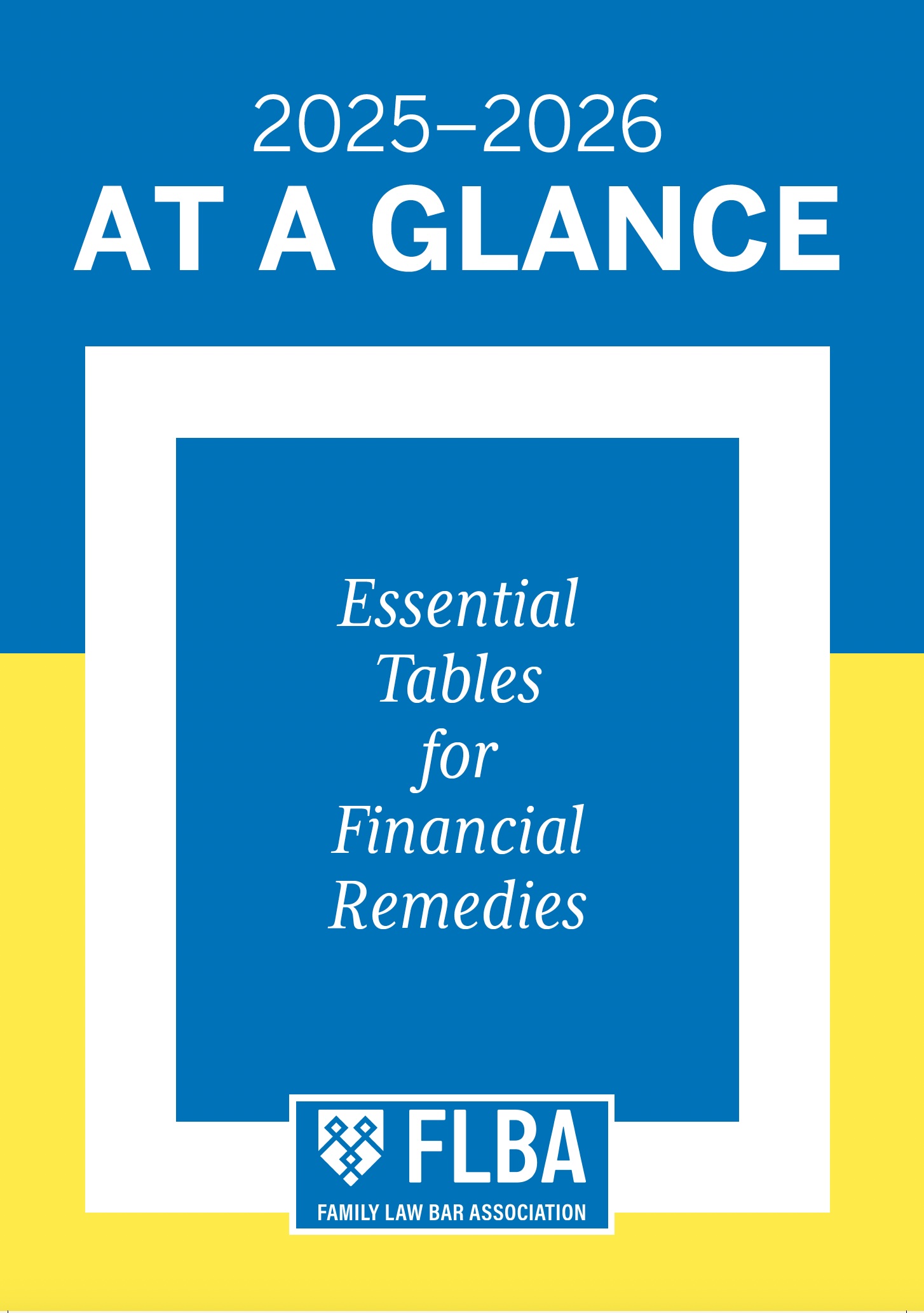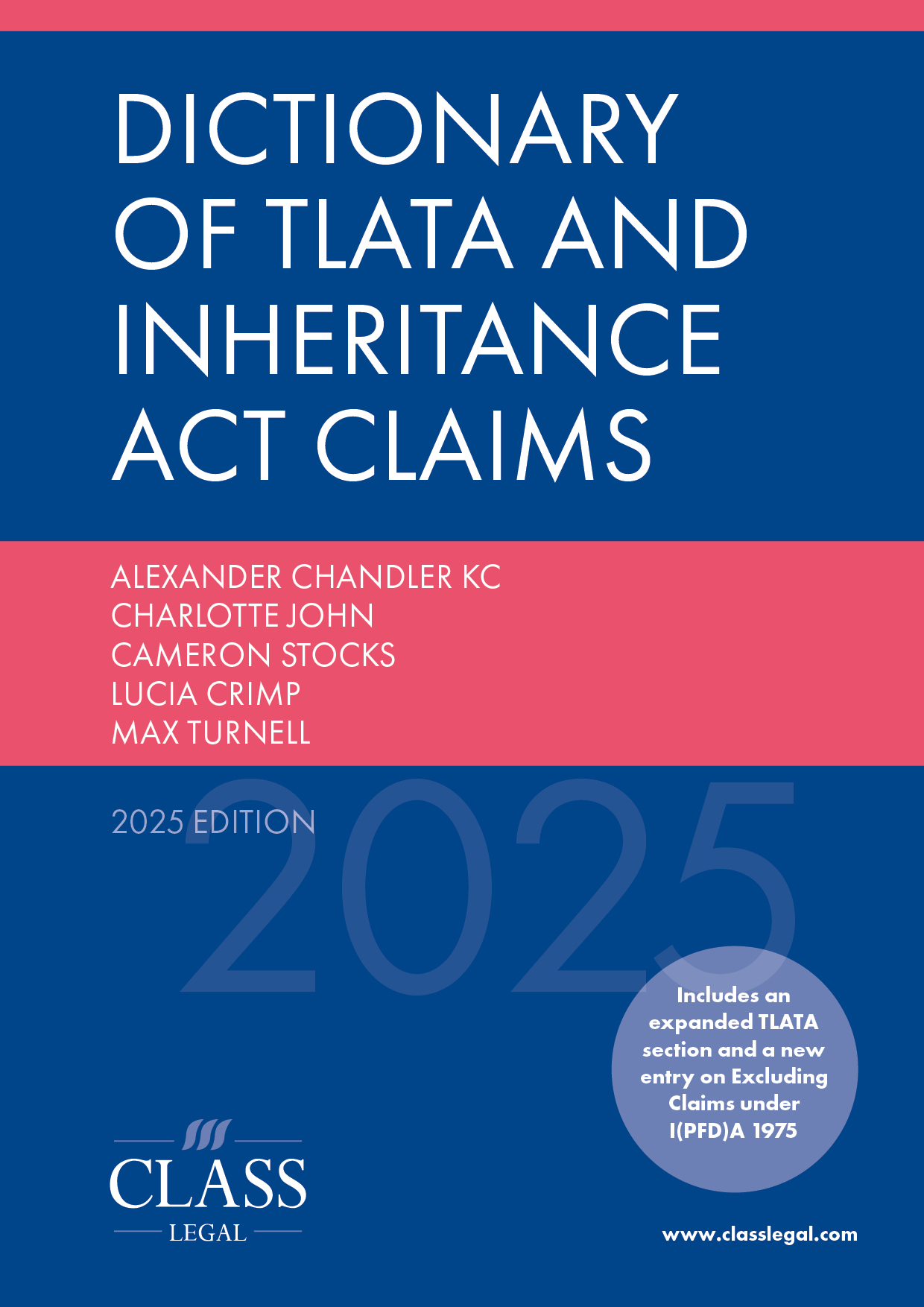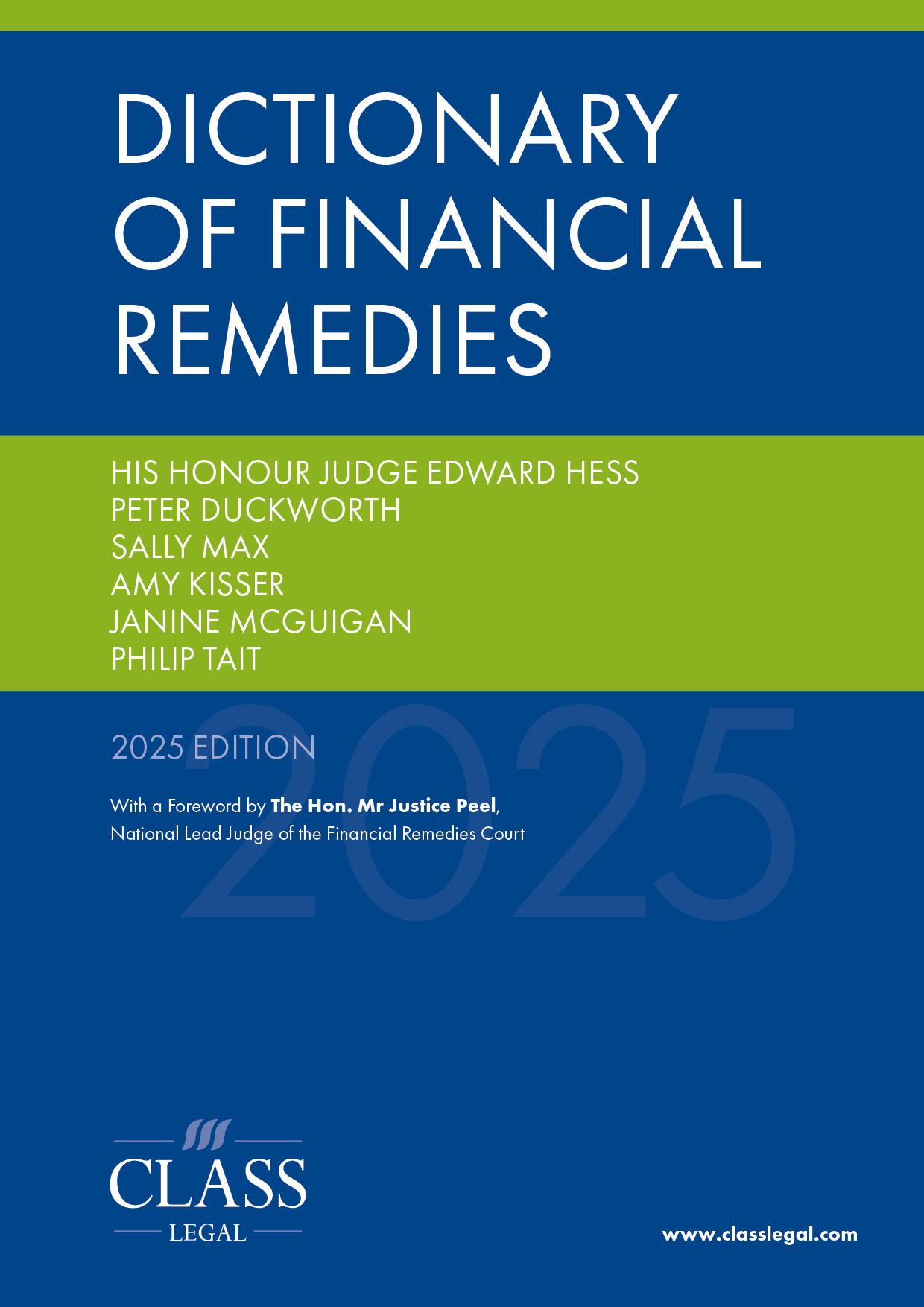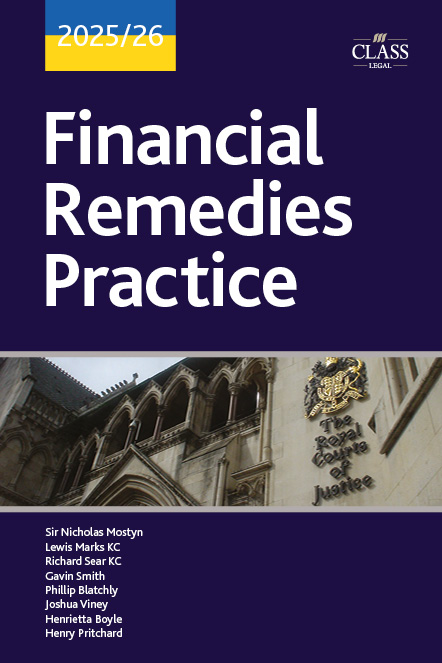
Domestic Abuse, Nuptial Agreements and Financial Remedies: A Cultural Shift?
Published: 18/03/2025 06:00

As family practitioners will know, the dynamics involved in negotiating nuptial agreements are no less nuanced than those in other parts of our work. There can be power imbalances, cultural clashes and differing perceptions of fairness.
As we become more alive to the prevalence and forms of domestic abuse and the ways in which the law and procedures don’t adequately support victims, it’s important that we apply that awareness to our work on nuptial agreements. The Fair Shares research identified that 29% of divorcees cited their partner’s domestic abuse or controlling behaviour as a reason for the breakdown of the marriage, with a recent follow-up report examining the impact on financial remedy outcomes.1 Resolution has also made recommendations for a ‘cultural shift from all family justice professionals to better meet the needs of victim-survivors of domestic abuse.’2 These findings raise the possibility that with the weight being given to nuptial agreements and the manner in which they are currently drafted, they are further disadvantaging victim-survivors of domestic abuse and may in some circumstances be an extension of coercive and controlling behaviour.
In this article, we consider options as to what a ‘cultural shift’ to better meet the needs of victim-survivors could look like in the context of nuptial agreements.
Option 1: More recognition of domestic abuse as a factor rendering nuptial agreements invalid or unenforceable under the current law
Domestic abuse at the time the agreement is entered
As the law stands, domestic abuse (including coercive and controlling behaviour) at the time an agreement is entered may be sufficient to meet the test of ‘undue pressure’ or ‘undue influence’ which would persuade the court to disregard a nuptial agreement. However, there is a lack of judicial consideration of the ways in which the doctrine of undue influence – as it has been developed in a property and commercial law context – may apply in the context of nuptial agreements. Given the history of undue influence as a vitiating factor to commercial guarantees in cases where wives have guaranteed their husbands’ debts,3 it is perhaps surprising that there has not been more cross-pollination. Considerations of whether one party has ‘acquired a measure of influence, or ascendancy’ over another, causing the other to place trust in that party to look after their affairs and interests (which trust is then abused), may be apt in nuptial agreement cases where there is a pattern of control, rather than specific incidents, which influences the decision to enter into the agreement.4
Recent case-law sees a narrow approach being applied to the vitiating factors which – either as a principle of contract law or upon the reasoning applied in Radmacher v Granatino5 – invalidate a nuptial agreement. If an agreement is not set aside, its provisions may be mitigated by the court adjusting the provision made to avoid unfairness. However, that will not assist parties in cases where the provision in the agreement is not unfair enough for the court to depart from it, but where a party entering it did so with no real autonomy or understanding of the decision (as may well be the case within the dynamic of a coercive or controlling relationship). Examples of this include:
(1) HD v WB made it clear that taking independent legal advice is not mandatory and its absence is not a vitiating factor, citing V v V, and Versteegh v Versteegh.6
(2) In BI v EN, Cusworth J gave a relatively narrow meaning to the parties needing to have a ‘full understanding of the implications’ of an agreement,7 holding that a contrat de mariage entered in France, where such agreements are routine, was fully understood by the wife despite her clearly not being in a position to have considered the possibility that she would later divorce in a jurisdiction with a discretionary system and no default property regimes. In HD v WB, Peel J found that the husband understood that ‘the purpose of the PNA was to protect assets and he knew that W’s assets all emanated from her family’, which was sufficient understanding for the agreement to be upheld. In Helliwell v Entwhistle, Francis J referred to the agreement as a ‘plain English document’ (despite having been drafted by solicitors) and the ‘broad gist’ being easy to appreciate.8
It seems not to be considered that a ‘full understanding of the implications’ of an agreement includes understanding the claims one is waiving, and the outcomes which may arise from the agreement being implemented in a range of real-life scenarios. ‘A full understanding of the implications’ has become ‘an appreciation of the broad gist’.
(3) Undue pressure was considered in the case of MN v AN, where Moor J held that it doesn’t mean any pressure.9 It was acknowledged that the wife was under pressure, but it wasn’t sufficient to vitiate the agreement (there had been ‘the mother of all arguments’, in the husband’s words).
(4) Judges have a tendency to refer to the parties’ academic or employment credentials when considering their level of age and experience. For example in BI v EN, Cusworth J referred to both parties as being ‘highly intelligent and educated people’. The wife was aware of her grandfather’s bankruptcy and the asset protection her mother had had in place in her own marriage, so she was not an ‘ill-informed ingenue’. However, little reference was made to the fact the parties were both in their twenties and childless at the time of the agreement. Whilst parties’ academic intelligence and experience of financial matters must be relevant to their understanding of the words of an agreement, Lord Phillips in Radmacher specifically referred to age and experience as being relevant to the parties’ ‘emotional state’ at the time of signing.
(5) Lastly, the Law Commission’s guidance that agreements should be signed at least 28 days before a marriage is re-affirmed in case-law as being no more than guidance.10 For example, in HD v WB, the pre-nup was entered into on the day of the wedding, but this wasn’t an issue in terms of the validity of the agreement as no one was in an ‘unseemly rush’.11 In Helliwell v Entwistle, the agreement was also signed on the day of the wedding, and was upheld.
These examples demonstrate what Dr Sharon Thompson identifies as a reluctance by the courts to engage in questions of whether autonomy has actually been exercised.12 There is a tendency to present divergence from a nuptial agreement as being in opposition to autonomy. This encourages judges to limit the application of needs to avoid appearing ‘paternalistic’. This concept of autonomy, however, is a narrow, neo-liberal one, which has been ‘simplified, neutralised, individualised and de-gendered’ (as Dr Thompson puts it). In other words, this version of autonomy assumes that the freedom to decide on the contents of an agreement represents autonomy, without considering how individuals go about making such decisions in practice.
In the context of intimate relationships and the increasing awareness of domestic abuse in the form of coercive and controlling behaviour, it would be more appropriate to adopt a fuller, more relational concept of autonomy. This requires a shift in emphasis away from a narrow list of vitiating factors and towards a more holistic view of what each party’s expectation and understanding was at the time of entering an agreement, and how changes in circumstances (of which domestic abuse is one example) may have frustrated those expectations.
Domestic abuse after the agreement is entered into
There is scope for a victim-survivor party to a nuptial agreement to persuade the court that the agreement should not be enforced as a result of domestic abuse taking place after the agreement was entered, on one of the following bases:
(1) It may be possible to set aside a nuptial agreement under the principle that a person shall not benefit from his own wrongdoing, particularly where the domestic abuse falls within the scope of the criminal offence.13 Joshua Thompson SC argues this principle applies to nuptial agreements as a matter of Australian law.14 In English law, the same common law principle (that a person shall not benefit from his own wrongdoing) underpins the defence of illegality, which acts a shield to civil claims, including claims for breach of contract.15 Arguably, the principle should apply where one party (A) commits domestic abuse, such that the other party (B) needs to leave the marriage, and then A seeks to rely on a nuptial agreement to deprive B of resources to which he or she would otherwise be entitled.
However, in an English court, this argument must fall down as nuptial agreements fall to be considered a ‘circumstance’ of a case under s 25 MCA 1973 (unlike in Australia, where nuptial agreements have a statutory footing). Authorities which are recent and specific to this area must take precedence over the common law defence of illegality, and have made it clear that ‘conduct’ under s 25(g) is limited to the categories set out in OG v AG,16 imposing a high threshold of exceptional conduct with a causal link to a financial consequence.17 Widening ‘conduct’ as a factor to be taken into account in financial remedy cases, including those involving nuptial agreements, would require a change in the law. Whilst evaluating reform of that kind is outside the scope of this article, we observe for these purposes that it would produce consistency between cases where domestic abuse impacts the implementation of an agreement and cases where domestic abuse impacts the implementation of arrangements pursuant to the s 25 exercise. In both cases, the concern is that outcomes do not do enough to mitigate the effects of domestic abuse on its survivors.18
(2) Alternatively put, in Australia Joshua Thompson SC and Jacky Campbell argue that courts ought to adopt an implied term in nuptial agreements that they will not be enforceable by a party who has perpetuated domestic abuse.19 It is implicit that when parties marry they intend to treat each other with dignity and respect. The failure of one party to do so undermines the basis of the legal relationship between them and it must be assumed that the parties would not have intended the agreement to apply in those circumstances. Thompson argues that this implied term is necessary for the efficacy of nuptial agreements as a whole, as it encourages their use by inspiring confidence that they will not be used as a tool to perpetuate abuse.
(3) Jacky Campbell further argues that agreements may be set aside in marriages where there is domestic abuse on the basis of inadequate legal advice.20 This would include the absence of advice on the rights attaching to domestic abuse survivors (particularly in the Australian context, where the Family Law Amendment Bill 2024 looks to codify the adjustments to property entitlements which can be made to respond to the effects of family violence).
Perhaps this could be drawn more broadly, in line with what we say about taking a more well-rounded view of autonomy which reflects the relational aspects of decision-making. Agreements might be set aside where the parties have not had advice about the prevalence or patterns of domestic abuse, or had their attention drawn to the ‘optimistic bias’ which can permeate decisions immediately prior to a wedding (as demonstrated by research cited in the Law Commission’s 2014 report21).
However, there are difficulties with pinning a party’s ability to resile from an agreement in the wake of domestic abuse to the advice they have received. Advice about domestic abuse would likely become standardised, both in order to shore up agreements and also to cover the backs of professional advisors who would understandably be nervous about accusations of negligence. Because of ‘optimistic bias’, even if advised about the risk of domestic abuse and the steps one would need to take to access rights as a survivor, many people assume it will not happen to them. They could be in a worse position for having been advised about the effects domestic abuse would have on the agreement, if the court considers (or assumes, if legal privilege is not waived) that the party seeking to resile has been made aware of the risk and chosen to enter the agreement anyway.
A difficulty with giving greater import to domestic abuse as a factor invalidating nuptial agreements is the potential uncertainty it creates. As the Law Commission’s recent Scoping Report highlights,22 in any areas where there is not settled law which is clear on the face of the statute, there is potential for litigation. With the Family Court system already creaking, who would determine the factual matrix in cases which, at present, require very little fact-finding as arguments about vitiating factors take a back seat compared to arguments about fairness and meeting needs? In how many cases would unresolved disputes about the factual pattern become an obstacle to out-of-court settlement? Critics of a broader approach to vitiating factors may also cite the risk that any party who is dissatisfied with the provisions of a nuptial agreement would be tempted to allege domestic abuse, flooding the court with claims.
However, the development of the law cannot solely be guided by the desire to avoid disputes about factual matters. There are laws of evidence and court procedures to distinguish between truthful and untruthful allegations. Whilst it is sensible to have one eye on the difficulties of operating those procedures in an underfunded system, it would be unjust to build a system which is designed to function without them at all. The consequences for dishonest litigants may also resound in costs.23
It is also important not to forget that in some cases the economically stronger party is the victim of domestic abuse. Any measure which could prolong the court process may be used as a tool for further control, and fact-finding processes in our adversarial system are not well-suited to supporting survivors of domestic abuse.24
Option 2: Changes to best practice in the drafting of pre-nups, to include a ‘domestic abuse clause’ or other safety nets
For those drafting nuptial agreements, there is an alternative way to mitigate the potential harm of an agreement which would impose a financial outcome in a domestic abuse scenario without taking account of that abuse – we could include clauses in our agreements setting out how domestic abuse should affect their enforceability or interpretation. This could be, for example:
(1) A clause providing that the onus will be on the party who has perpetrated the abuse (with the standard of proof being the balance of probabilities) to demonstrate that the agreement should be upheld.
(2) A clause providing that the agreement will be voidable if either of the parties perpetrates domestic abuse.
(3) A clause providing that the parties will treat each other with dignity and respect throughout the marriage, with specific recognition that abuse can take the form of emotional abuse, economic abuse, and coercive and controlling behaviour.
Of course, any such suggestions would need to take account of the possibility of the perpetrator of the abuse alleged being the financially weaker party. It may advantage that party to say that the agreement may not be upheld if abuse takes place. So what is the answer in those cases – that that party will need to show why (even) their needs should be met? That their needs would be interpreted at the less generous end of fairness? That Schedule 1 concepts may be imported where there were none in the agreement?
Thought would also need to be given to how allegations of domestic abuse are verified for the purpose of such clauses. As discussed, this is a potential difficulty with any measure which makes domestic abuse a (more) material factual consideration. As pre-nups are generally intended to reduce the need for protracted litigation, it may not sit well with parties who enter them for the measure of whether domestic abuse has taken place for the purposes of the agreement to be a finding of fact in the Family Court.
However, accepting those deficiencies, there are potential advantages to introducing these clauses. It is an option which puts the ‘cultural shift’ towards recognising the effects of domestic abuse into the hands of lawyers and their clients. Discussions about pre-nuptial agreements in particular, taking place in the run up to marriages, are an opportunity to open up the conversation about domestic abuse, empowering parties to recognise the signs of domestic abuse so that they can seek help if needed.
The use of ‘domestic abuse clauses’ is clearly not a panacea. It would only impact upon the small percentage of divorcing couples who have entered into nuptial agreements,25 in practice more prevalent amongst wealthier couples. Although wealthy couples are not immune from domestic abuse, there is the risk of a ‘2-tier system’, where bespoke agreements respond to domestic abuse but those whose cases are dealt with by the general law are disadvantaged by the abuse they have suffered. A wider consideration of the law on ‘conduct’ would, as noted above, be more able to create consistency in this area.
Conclusions
Taking all of this together, there is scope for current law and practice around nuptial agreements to go further in protecting survivors of domestic abuse:
(1) A more holistic approach to the factors influencing parties’ decisions to enter agreements would create more scope for agreements to be vitiated where they do not represent a true exercise of autonomy (conceived in its fuller, relational sense), including where a controlling pattern or dynamic has influenced the decision to enter an agreement.
(2) There are potential legal bases on which nuptial agreements may be disregarded if domestic abuse has taken place after one was entered into, but these are difficult to apply in an English context because of the precedence of s 25 and the high threshold imposed upon ‘conduct’ in that context.
(3) Practitioners may use the drafting of nuptial agreements as an opportunity to emphasise the materiality of domestic abuse, or at least to open up the conversation about domestic abuse and ensure clients are aware of the signs and how to access help.
We note that the options we set out may be regarded as controversial and going against the grain of some calls for reform. The Law Commission’s recent Scoping Report was clear that there needs to be more certainty in financial outcomes, which would be served by the principle that pre-nups are iron-clad.26 Stakeholders in the over-burdened court system will say that more cases need to be dealt with outside court and a balance needs to be struck between responding appropriately to domestic abuse and enabling parties to avoid litigation in an area which is already contentious. But as we draft more nuptial agreements, and with domestic abuse sadly rife, these are topics with which we all need to engage.









